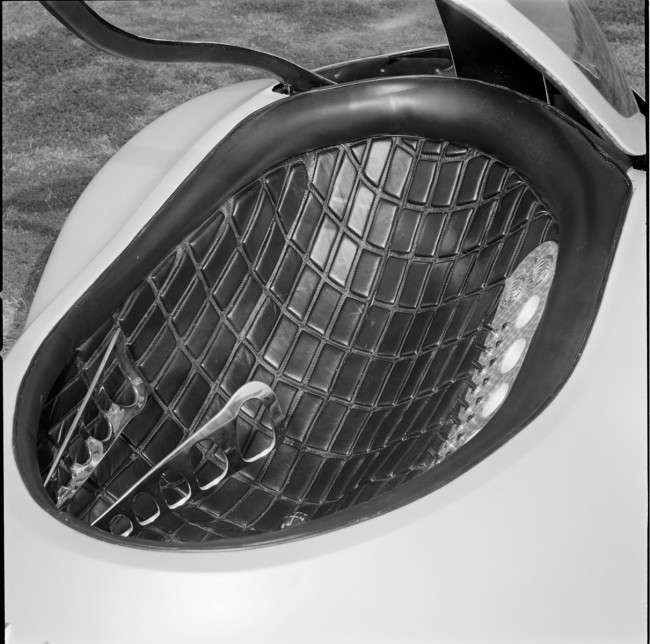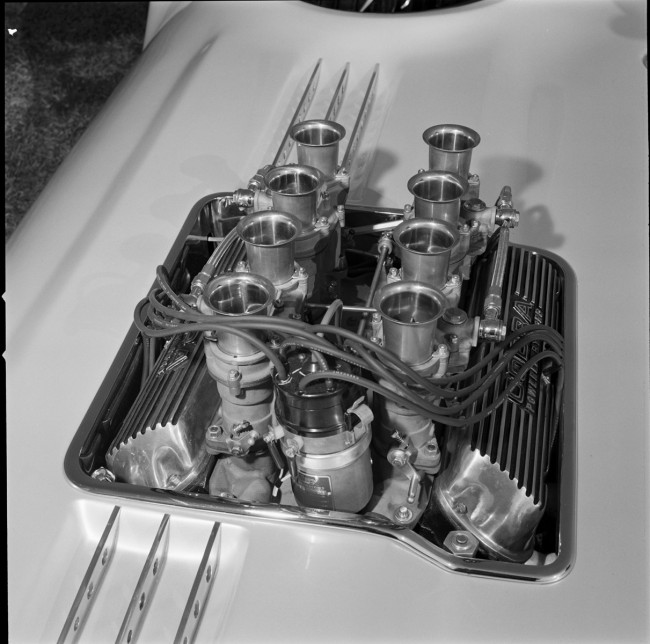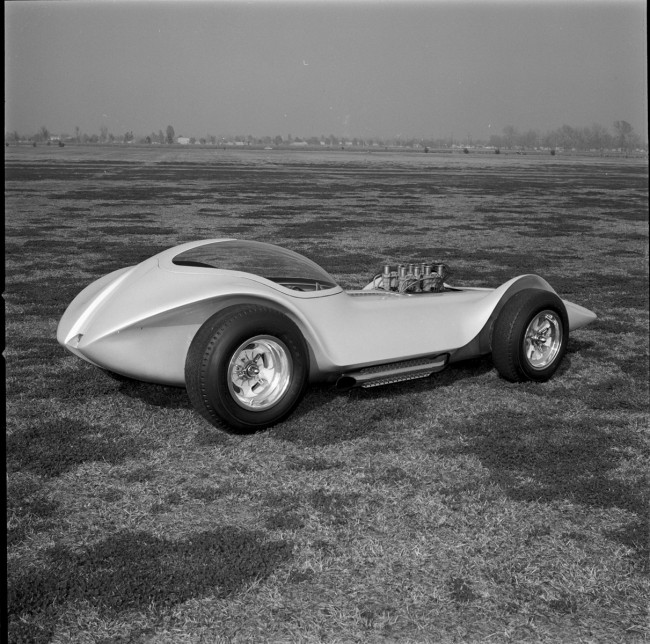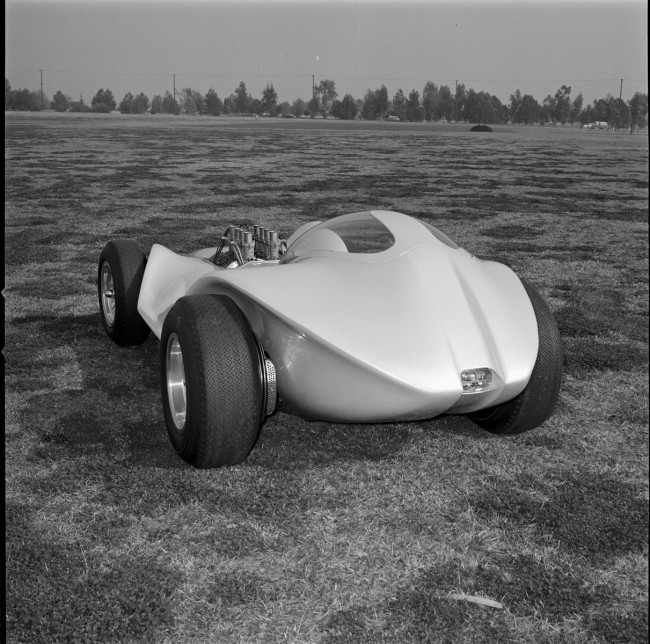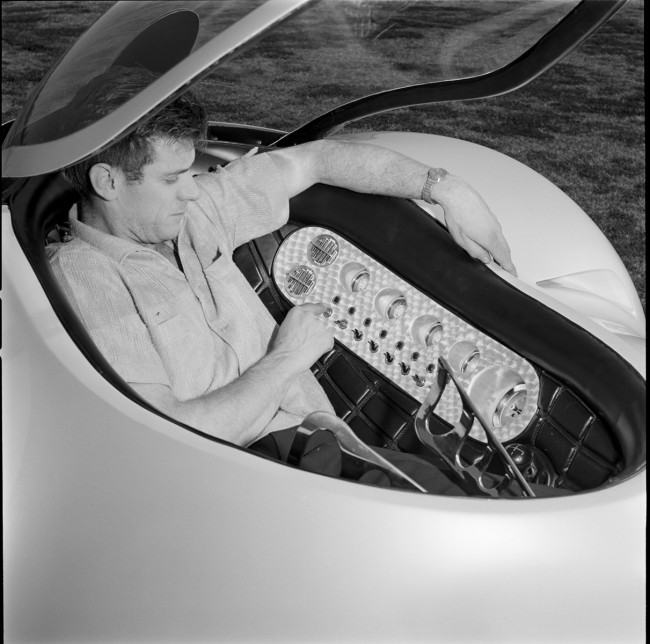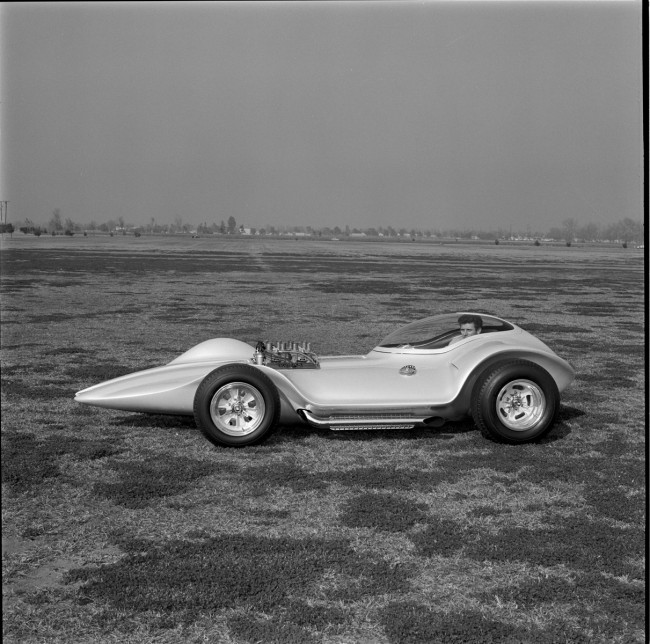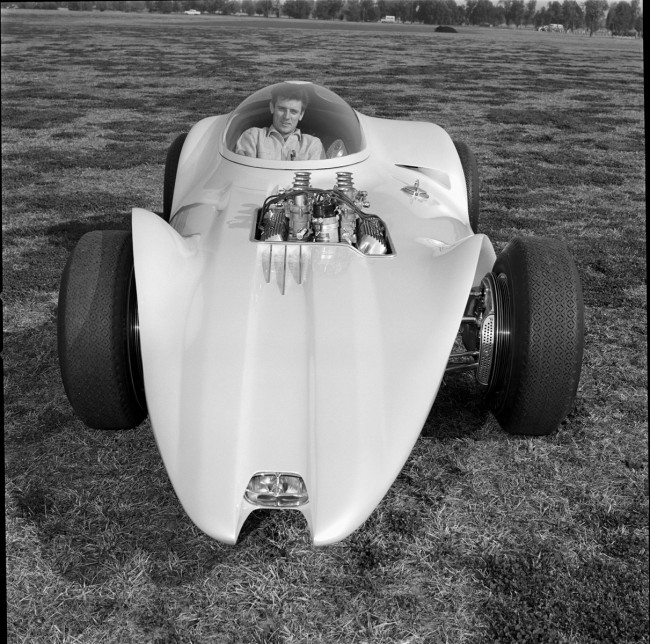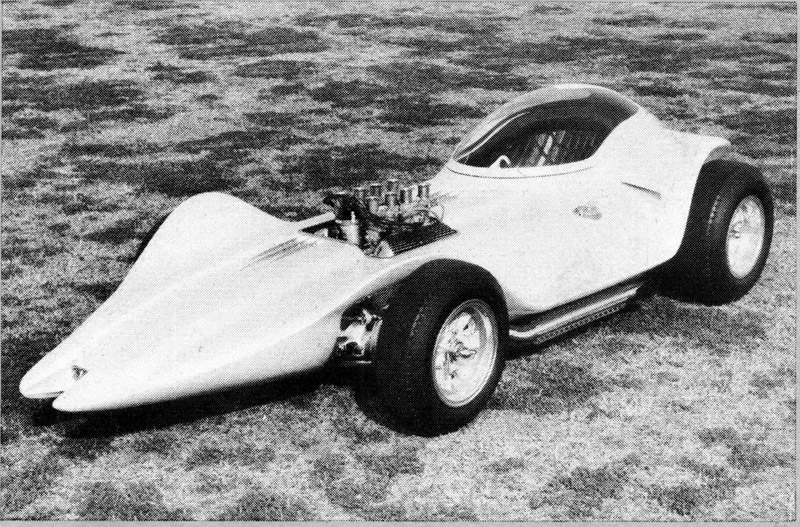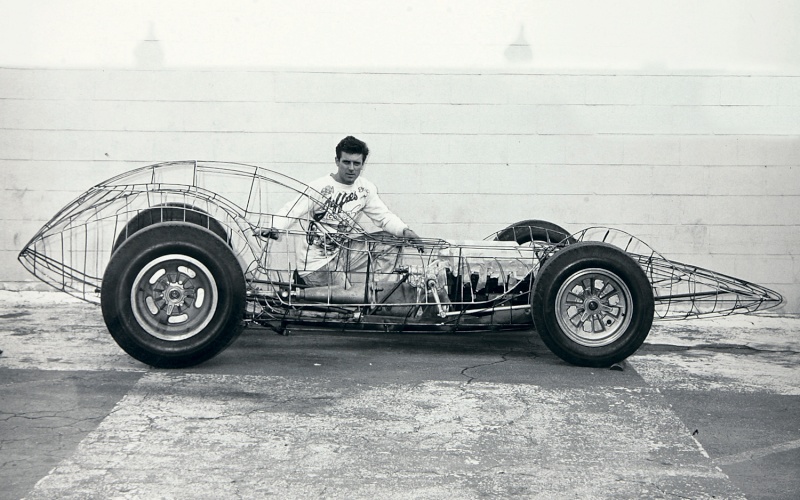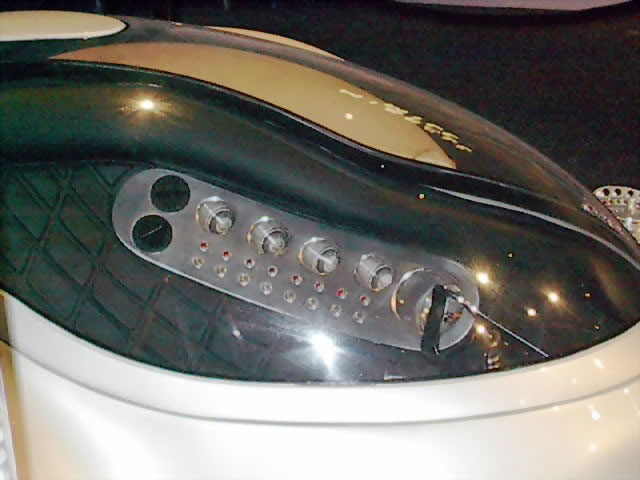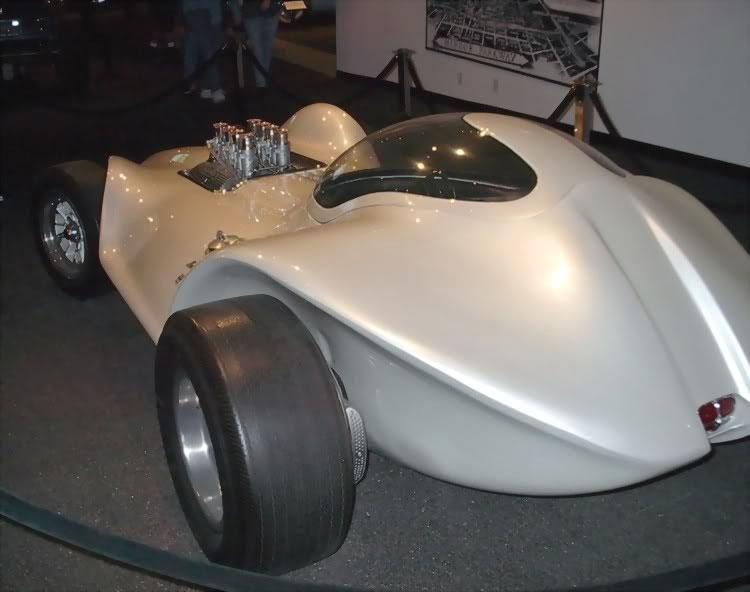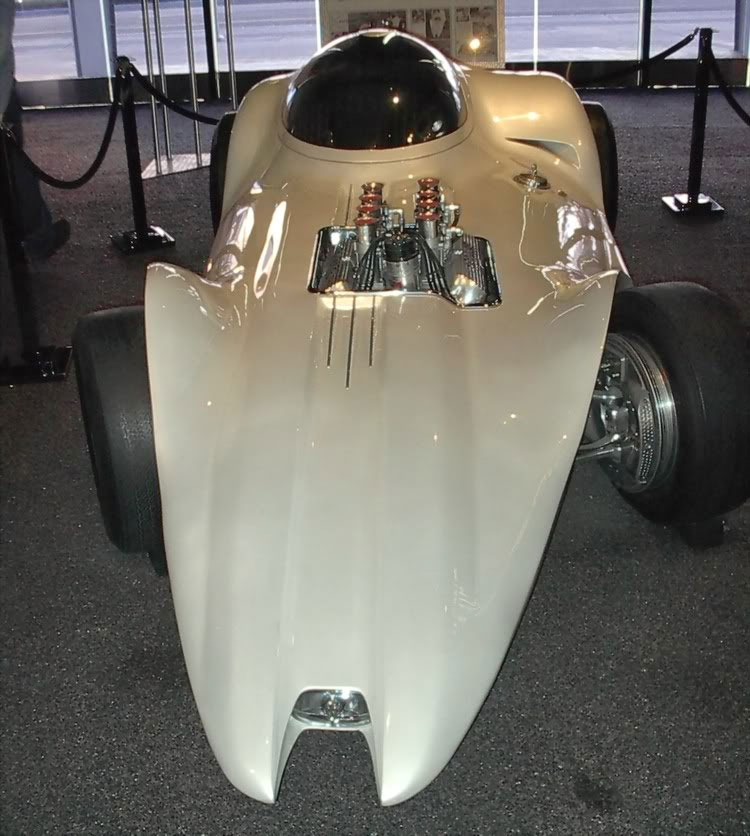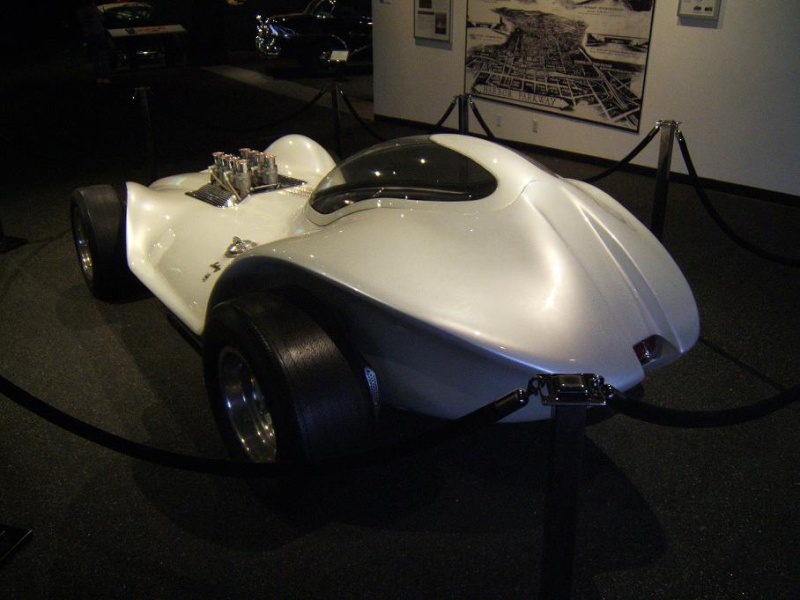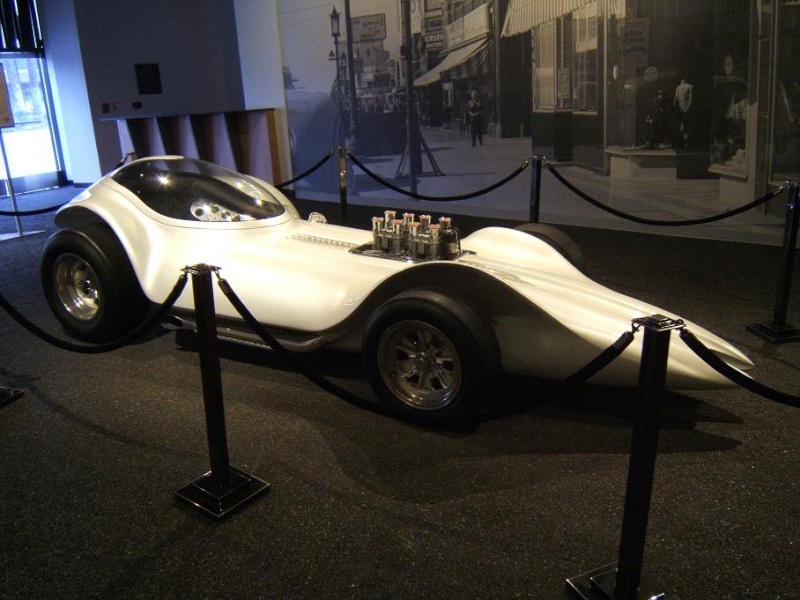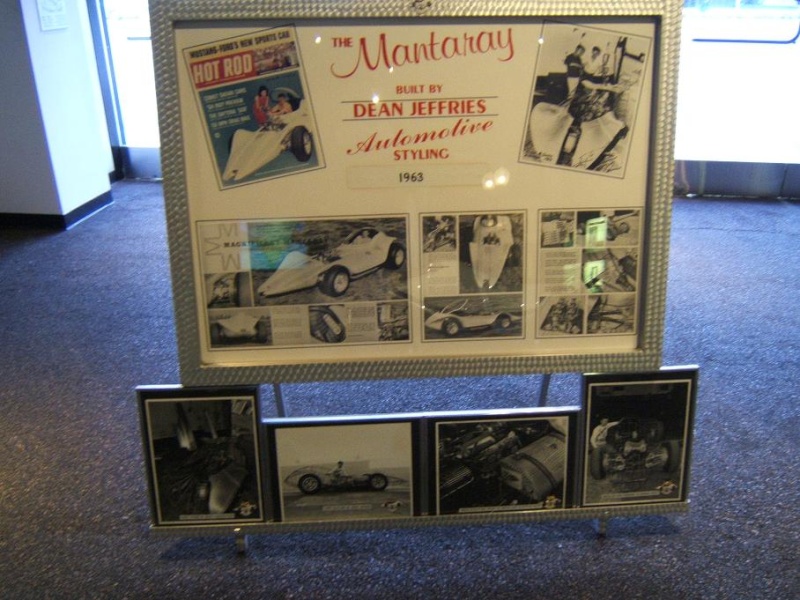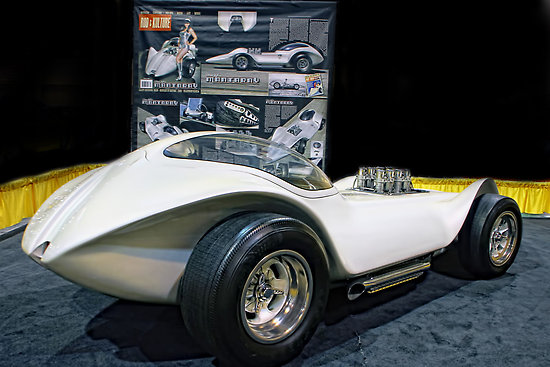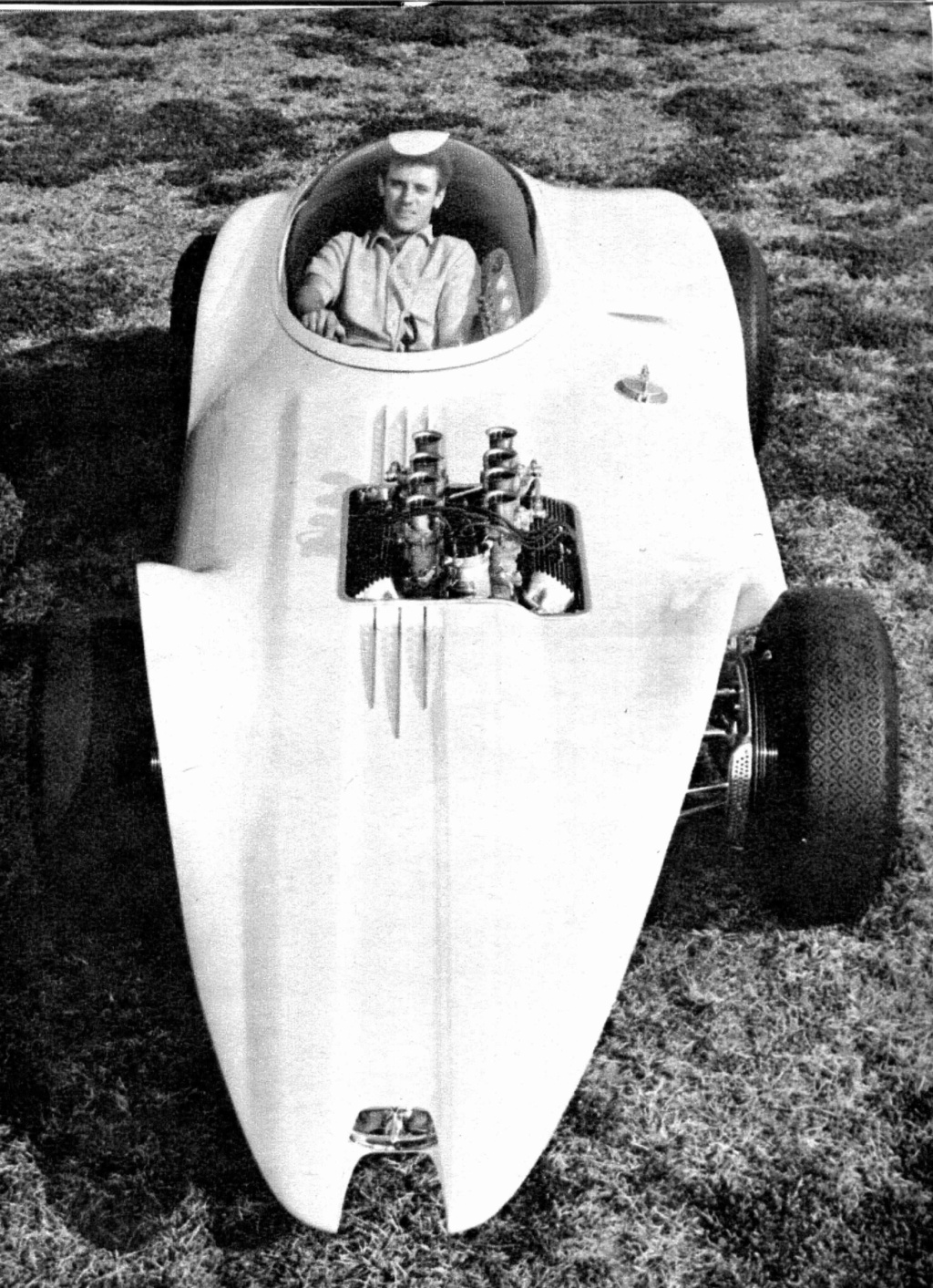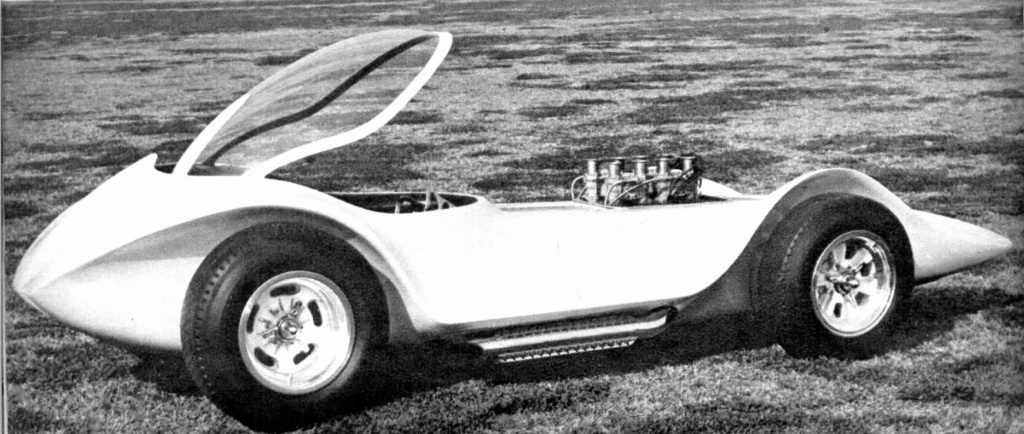The Mantaray - Dean Jeffries
Traditional Kustom Hot Rod and Vintage Culture and design :: Mild & radical Custom cars database :: Concept Custom Car
Page 1 sur 1
 The Mantaray - Dean Jeffries
The Mantaray - Dean Jeffries
The Mantaray is a show rod built by Dean Jeffries.
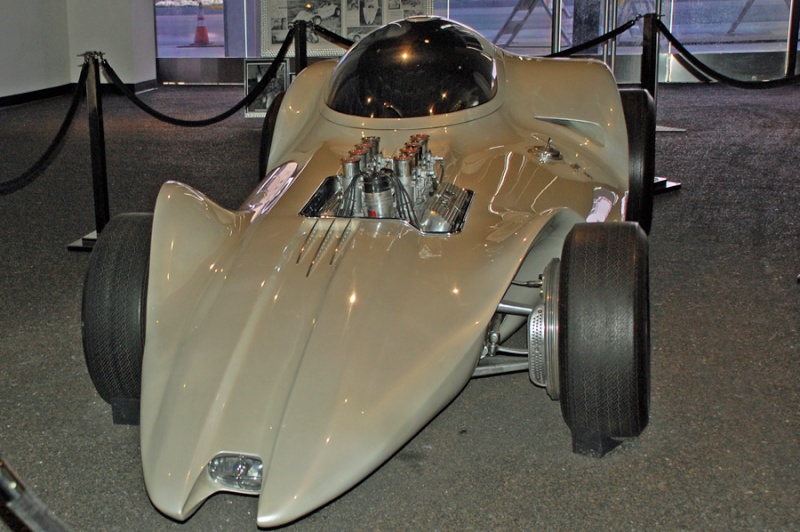
Dean Jeffries's Mantaray
One Piece Beauty that's Both Futuristic and timeless
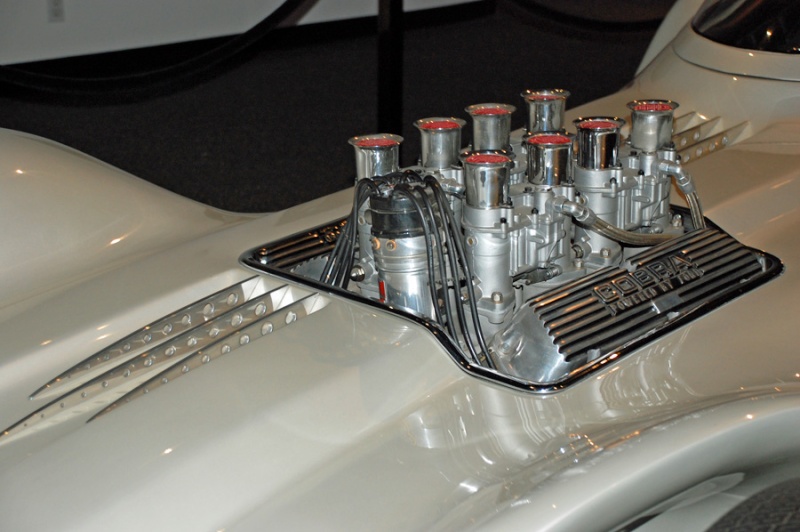
When the name Dean Jeffries pops up in conversation, most car guys will automatically nod in agreement that, yes, this is one man who truly understands cool customs, wild flames, and precise pinstripes. After all, those were Jeffries's stocks-in-trade when he stepped forward as a major player in the custom car field back in the 1950s. His emerging presence also added credence to the phrase "Von Dutch and The Kid." Back in those days Jeffries hung out with the social-misfit Kenneth Howard, in the process learning his skills as a painter and striper. You've probably figured out by now that Jeffries was "The Kid" of the duo.
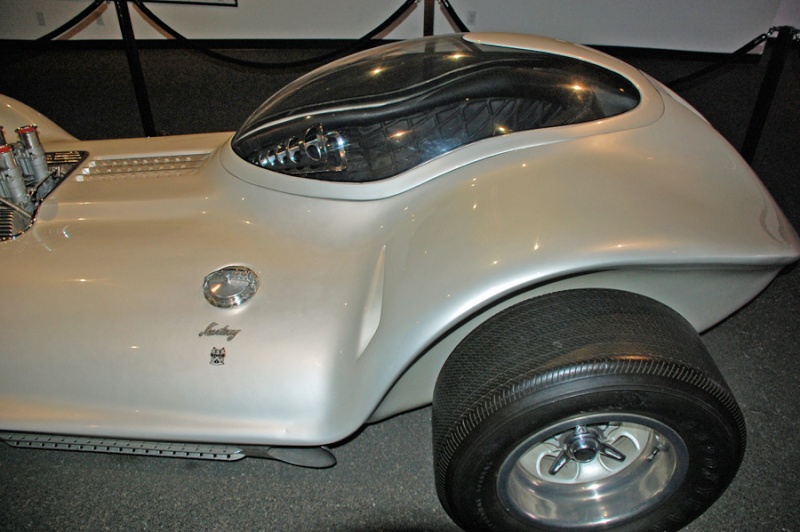
Despite his reputation as a customizer, The Kid's first love happened to be racing. In fact, racing has always been Jeffries's passion, and today he'll tell you, "Racing has been my whole life." His romance with the racetrack eventually led to the creation of the Mantaray, but before you can appreciate why he built this street-rod-cum-show-car, it's best to understand how Jeffries became hooked on racing in the first place.
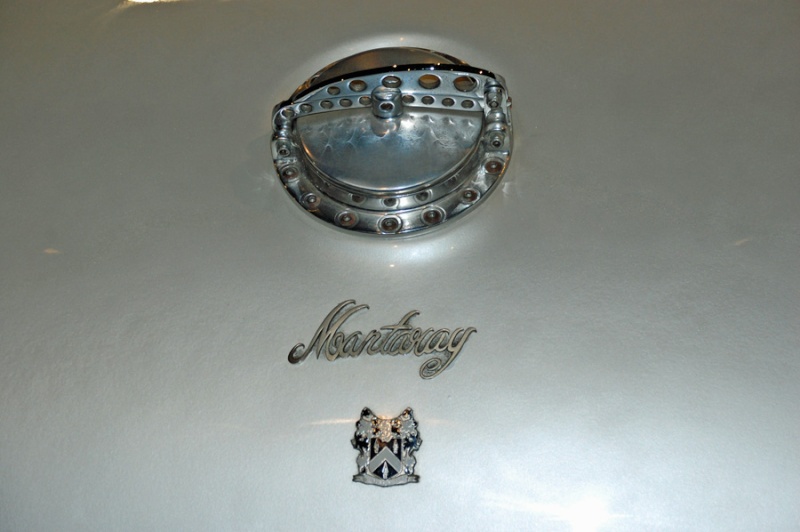
Jeffries grew up in the town of Compton, California, home of many early-day hot rodders and racers. One aspiring racer who happened to live only a few houses down the block from young Jeffries was Troy Ruttman. Sharing an interest in cars, they became good friends. Ruttman, in particular, happened to be a fledging driver with a promising career. Tall and dashing, with handsome looks and lightning reflexes, Ruttman personified the typical race car driver of that time. In 1949 he landed his first ride at The Brickyard, finishing 12th in the 500 behind the wheel of the Carter Special. By 1951 he was driving for the legendary J.C. Agajanian, and together they won the greatest race of them all in 1952.

That also happened to be the year Ruttman's friend, Dean Jeffries, showed up at Indy with his box of horsehair brushes and paint bottles, ready to do work. He spent the month striping race cars and drivers' helmets, and he established a reputation among Gasoline Alley tenants when he striped the Agajanian car.

"I just worked at it night and day," recalls Jeffries about those early years at Indy. His annual pilgrimages to Indy not only helped him establish a reputation as a hot-shot striper, he also picked up a few race car-building techniques along the way. By 1960 he had become a rather proficient innovator and metalman, although to this day he says he was never truly a fabricator. Maybe history will judge differently, especially for automotive historians who use Mantaray when gauging Jeffries's talents.

Dean Jeffries's Mantaray
One Piece Beauty that's Both Futuristic and timeless

When the name Dean Jeffries pops up in conversation, most car guys will automatically nod in agreement that, yes, this is one man who truly understands cool customs, wild flames, and precise pinstripes. After all, those were Jeffries's stocks-in-trade when he stepped forward as a major player in the custom car field back in the 1950s. His emerging presence also added credence to the phrase "Von Dutch and The Kid." Back in those days Jeffries hung out with the social-misfit Kenneth Howard, in the process learning his skills as a painter and striper. You've probably figured out by now that Jeffries was "The Kid" of the duo.

Despite his reputation as a customizer, The Kid's first love happened to be racing. In fact, racing has always been Jeffries's passion, and today he'll tell you, "Racing has been my whole life." His romance with the racetrack eventually led to the creation of the Mantaray, but before you can appreciate why he built this street-rod-cum-show-car, it's best to understand how Jeffries became hooked on racing in the first place.

Jeffries grew up in the town of Compton, California, home of many early-day hot rodders and racers. One aspiring racer who happened to live only a few houses down the block from young Jeffries was Troy Ruttman. Sharing an interest in cars, they became good friends. Ruttman, in particular, happened to be a fledging driver with a promising career. Tall and dashing, with handsome looks and lightning reflexes, Ruttman personified the typical race car driver of that time. In 1949 he landed his first ride at The Brickyard, finishing 12th in the 500 behind the wheel of the Carter Special. By 1951 he was driving for the legendary J.C. Agajanian, and together they won the greatest race of them all in 1952.

That also happened to be the year Ruttman's friend, Dean Jeffries, showed up at Indy with his box of horsehair brushes and paint bottles, ready to do work. He spent the month striping race cars and drivers' helmets, and he established a reputation among Gasoline Alley tenants when he striped the Agajanian car.

"I just worked at it night and day," recalls Jeffries about those early years at Indy. His annual pilgrimages to Indy not only helped him establish a reputation as a hot-shot striper, he also picked up a few race car-building techniques along the way. By 1960 he had become a rather proficient innovator and metalman, although to this day he says he was never truly a fabricator. Maybe history will judge differently, especially for automotive historians who use Mantaray when gauging Jeffries's talents.
_________________
We don't care the People Says , Rock 'n' roll is here to stay - Danny & the Juniors - 1958
 Re: The Mantaray - Dean Jeffries
Re: The Mantaray - Dean Jeffries

But when Jeffries built the Mantaray in 1963, he didn't care about what history held in store for him or his single-seat creation. Instead, he had his eye on the grand prize that Oakland Roadster Show promoter Al Slonaker had posted in the form of the Tournament of Fame. As the name indicates, this was a special competition, open to only a select number of pro-builders. It would be akin to inviting only guys like Boyd Coddington, Roy Brizio, and Ed Pratt to compete for a special prize today. Bill Cushenbery won the first Tournament of Fame, taking home the gold with his bubbletop Silhouette. For his efforts he earned a trip to Europe, a large cash prize, and a free automobile.

The tournament appealed to Jeffries, and he became an entrant for 1964. The car that he planned to build would showcase the talents that he had acquired during the years as a custom car builder, painter, and Gasoline Alley refugee every May at Indianapolis.
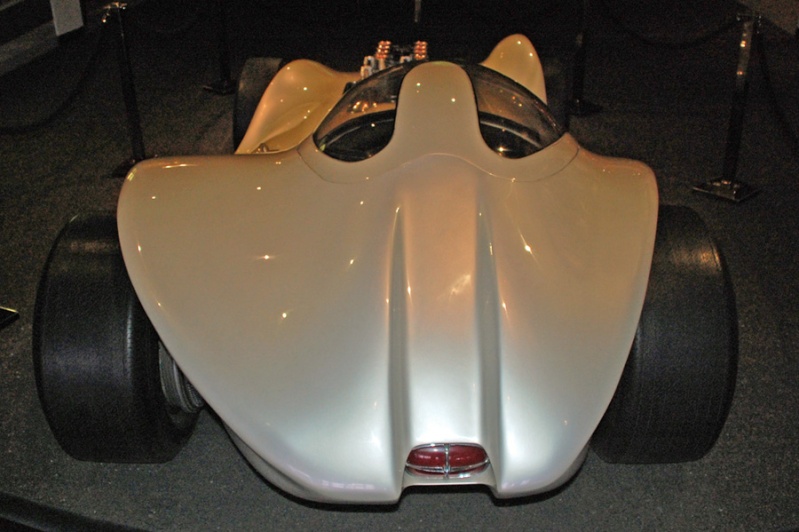
Let's freeze-frame our story for a moment to point out another interesting chapter in Jeffries's career as a car builder. In 1962 he went to work for Carroll Shelby who, at that time, possessed only the idea for the soon-to-be Cobra sports car. Shelby's plan was to take a lightweight two-seat sports car, wedge a brutish American-made V-8 engine under its hood, and go racing. Originally, Shelby ventured to Chevrolet with his proposal, but the Bow Tie boys cordially showed him to the door; as it turned out, they were building a hot-shot version of the new Corvette Sting Ray, called the Z06 racer.
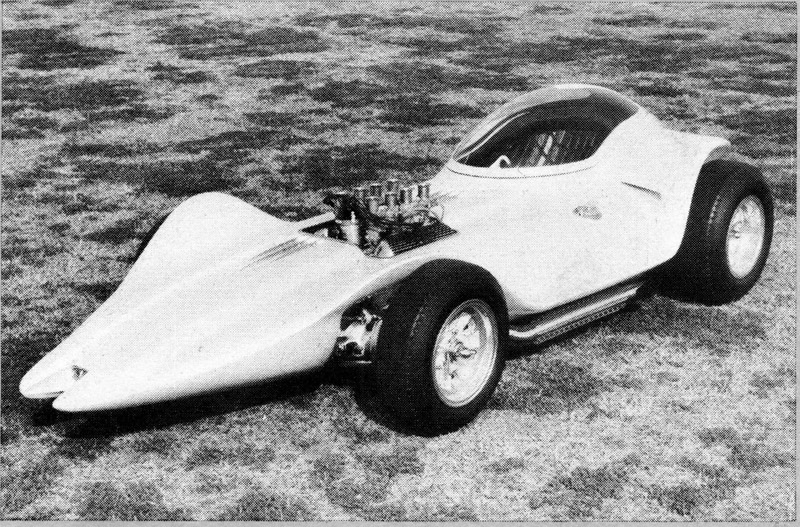
So Shelby did what any enterprising young American would do--he went to the next door on the block, which happened to be Ford Motor Company, and gave the same sales pitch. At the time Ford didn't have anything like the Sting Ray in the works, so they obliged with a couple of small-block V-8 motors for Shelby to play with. When he returned to his headquarters in Los Angeles, Shelby turned Jeffries loose to build the first Cobra, a car based on the aluminum-skinned AC Bristol, a British sports car that pretty much fit the parameters set by Shelby. Moreover, this project allowed Jeffries to hone his aluminum-fabricating skills that would prove invaluable a few months later when he started work on Mantaray.
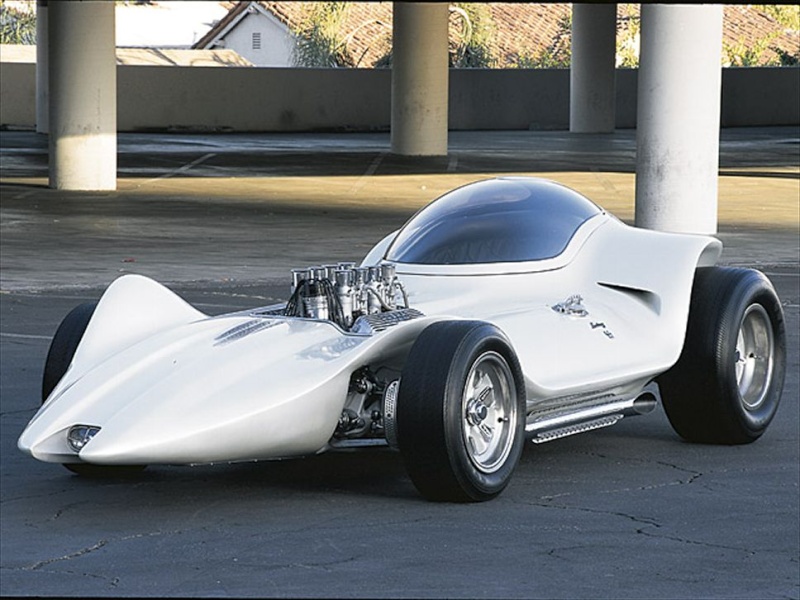
Jeffries is the first to admit that he's no engineer. Given that, he wasted little time trying to concoct his own chassis for Mantaray. Instead, he dusted off a couple of old Maserati Formula 1 Grand Prix cars that he had acquired a few years earlier from his first father-in-law. Jeffries makes it clear that, contrary to what has been written in the past about his car, Mantaray's frame is not based on the fabled Maserati Birdcage, which happened to be a two-seat sports car. Mantaray is a single seater, based on a Formula 1 car of questionable 1950s vintage: "I really can't remember what year the Maseratis were built," Jeffries points out today.

In any case, he pirated the best parts from both chassis, then went to work building his entry for the 1964 Tournament of Fame. First thing he did was trash the temperamental Italian engines ("Boy, was that a big mistake! Do you realize how much those are worth today?" Jeffries will tell you now.). Naturally, the old sheetmetal was scrapped, too, as were a few other choice parts. But for the most part the frame, suspension, brakes, and steering remain Italian-made. The rest of the car, with exception of the four downdraft Weber carburetors, is true-blue American, right down to the 15-inch magnesium-cast Halibrand wheels and the bred-for-Indianapolis Goodyear Blue Streak Speedway Special tires.
_________________
We don't care the People Says , Rock 'n' roll is here to stay - Danny & the Juniors - 1958
 Re: The Mantaray - Dean Jeffries
Re: The Mantaray - Dean Jeffries
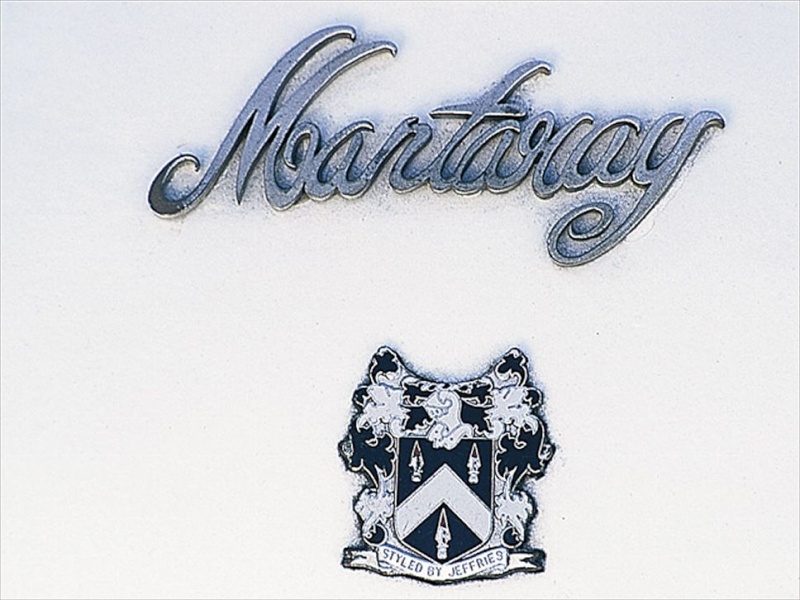
No doubt, Mantaray's curvaceous lines are stunning, reflecting a true work of art. But the real beauty that any skinned-to-the-knuckles street rodder can appreciate is in how Jeffries created that body. First, know this: it took 86 individual pieces of sheet aluminum to form that luscious body, each part pounded into shape by hand. Knowing that, it's challenging to examine the 36-year-old body up close to see where the weld seams lie. Whether you have the eyes of a 62-year-old or a 26-year-old, you'll be hard pressed to see where Jeffries set the bead back in '63.
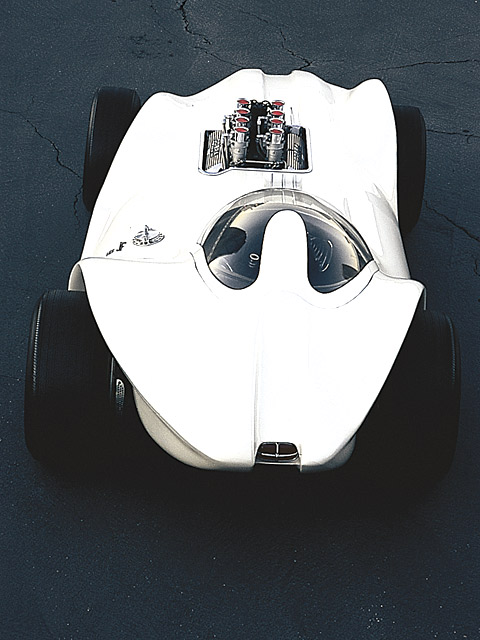
For all it's worth, the body appears to be formed from a single piece of material. Gaze at it some more and you tangle with another thought: How the heck does it come off the frame? Well, according to Jeffries, the sleek body was engineered for easy removal, and in fact body and frame spent a number of years separated when Mantaray was retired from the show circuit a few years after its conception. Recalls Jeffries, "I really didn't have any use for it (Mantaray) any more, but I didn't want to get rid of it, so I yanked the body and hung it from the ceiling, and parked the rest of the car in the corner of the shop." Fortunately for hot rod posterity he never pilfered parts from the car for other projects, so it took little work to restore Mantaray a few years ago. Essentially, Jeffries applied a new coat of pearl white, polished some odds and ends, and rolled the finished product into the Petersen Automotive Museum where the car resides today.
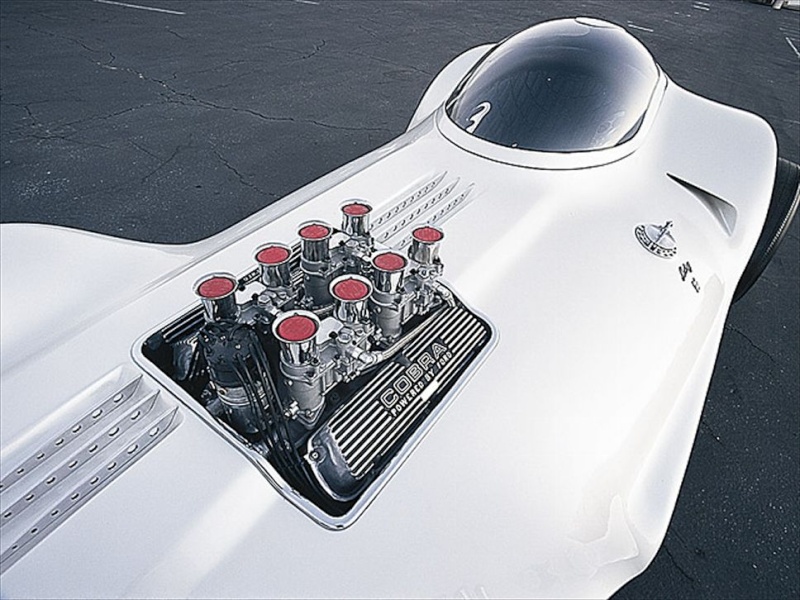
It's worth pointing out, too, that the body rests on a series of sub-frame attachment points strategically placed throughout the Maserati frame. "I took tricks for building an Indy car, and used them for this car," explains Jeffries.

One trick he had to learn himself was in working with plexiglass to form the bubbletop. Bubbletops were vogue among show cars back in the early 1960s, and while some builders enlisted the assistance of huge pizza ovens to mold their Plexiglas tops during that same time, Jeffries fashioned Mantaray's top the old-fashioned way. He used a tube to blow air into molten plastic, until it bubbled to the proper size. "Then I let it cool overnight, came back and cut and formed it," he tells us today. He makes it sound simple, but even Jeffries realizes that what he accomplished was pretty special when he adds, "And I only had to make one!"

When you listen to Jeffries talk matter-of-factly about how he built this car, you get the impression that he can do anything with his hands. For instance, consider the dragster steering wheel that he formed from ordinary steel stock. Jeffries gives a rather colorful and straightforward description of how he built it: "I just heated it, bent it, then had it chromed." So simple for a guy of his talents.
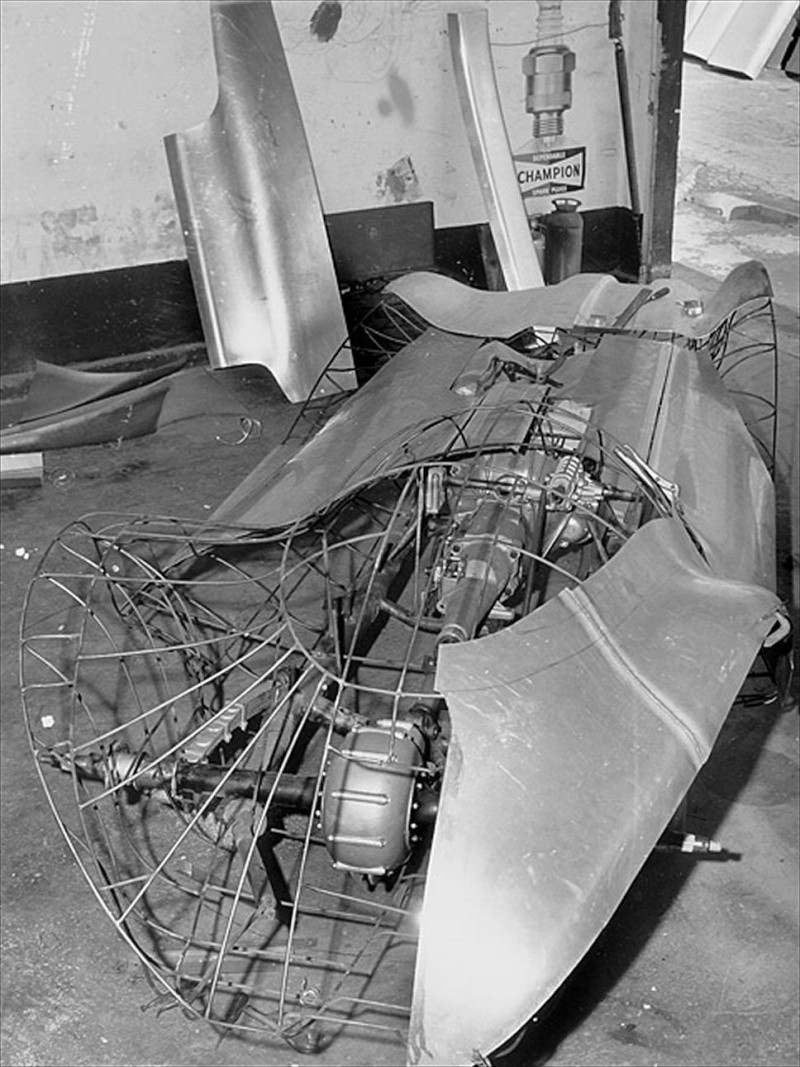
One thing that Jeffries couldn't do himself, though, was stitch the leather upholstery. For that he called on his good friend, Roy Gilbert, whose needle and thread later would help form the interior to many Jeffries creations, including various Hollywood cars such as the Monkeemobile and the Green Hornet's car.
_________________
We don't care the People Says , Rock 'n' roll is here to stay - Danny & the Juniors - 1958
 Re: The Mantaray - Dean Jeffries
Re: The Mantaray - Dean Jeffries

But Mantaray's interior proved to be more difficult to cover with leather than it looks. The seat has multiple curves that converge into a single point, making it difficult to form a contiguous pattern. Even so, Jeffries and Gilbert succeeded in creating a cockpit that followed the car's theme, in which the entire seat cover appears to have been formed from a single piece of cowhide. Jeffries didn't have to apply as much elbow grease with the engine. It's not by chance that he selected a small-block Ford V-8 with Cobra valve covers. Remember, he was working for Shelby at the time, and as partial payment for his work on the Cobra project, Jeffries was rewarded with a complete race-ready motor and 4-speed transmission. Boasts Jeffries today, "And the motor has only a few miles on it." Think about that, all you Cobra fanatics!

Actually, the entire car appears as fresh today as when he rolled it into the Oakland show arena on February 14, 1964. Nine days later, February 23, he rolled out with the Tournament of Fame first-place prize. "I won $10,000, a trip to Europe, and a new car," recalls Jeffries, "so I guess it was worth [building] it."

Later the car appeared in the movie Beach Blanket Bingo, in which a Hollywood character dressed in a gorilla suit made his grand appearance behind the steering wheel. All monkey business aside, Mantaray was a major draw on the show car circuit during the late 1960s, and received a multi-graphic paint job at one point in its life. An air scoop was added, too, in order to give the car a fresh appearance in its waning years as a celebrity feature car.
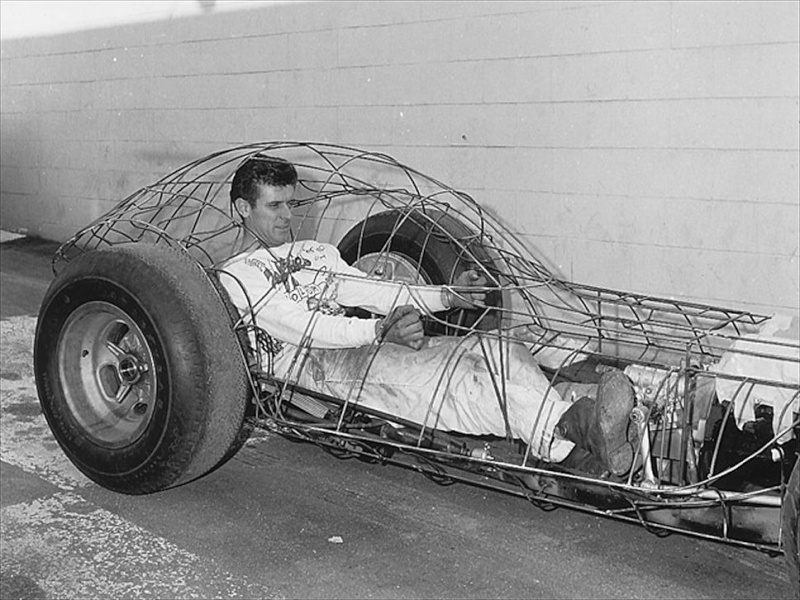
One more thing worth noting about Mantaray. Jeffries conceived the name one day while he was holed up in his hotel room during the weekend of the Monterey Kar Kapades car show. "I was looking out the window at the ocean," recalls Jeffries, "and I saw a Manta Ray. That's when I decided on the name."
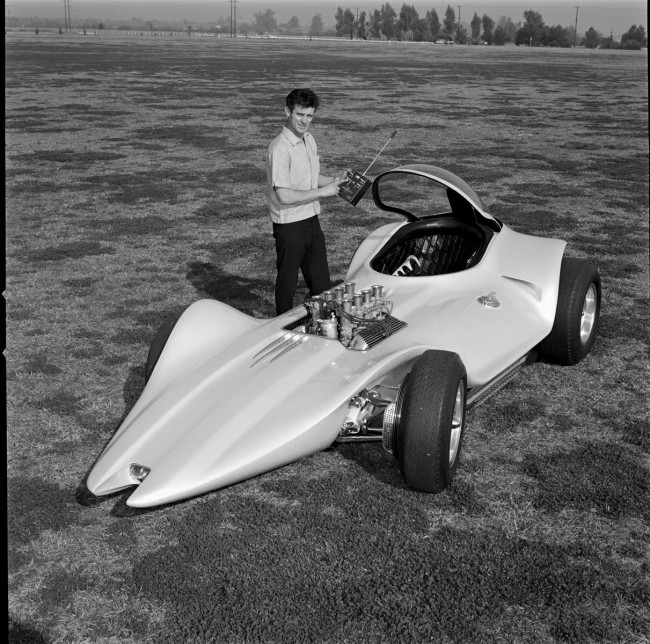
In the process he exercised a little owner's prerogative when he formed the name into a single word. Show promoters and magazine writers insisted on spelling it the proper way--Manta Ray--but Jeffries says the name should be spelled as one word. Which makes sense, because it helps maintain the purity and integrity of the design. A design that pleases the eye with its flowing, one-piece beauty, making this perhaps the first smoothie street rod ever built. Think about that while you search for the 86 individual body sections of Mantaray.
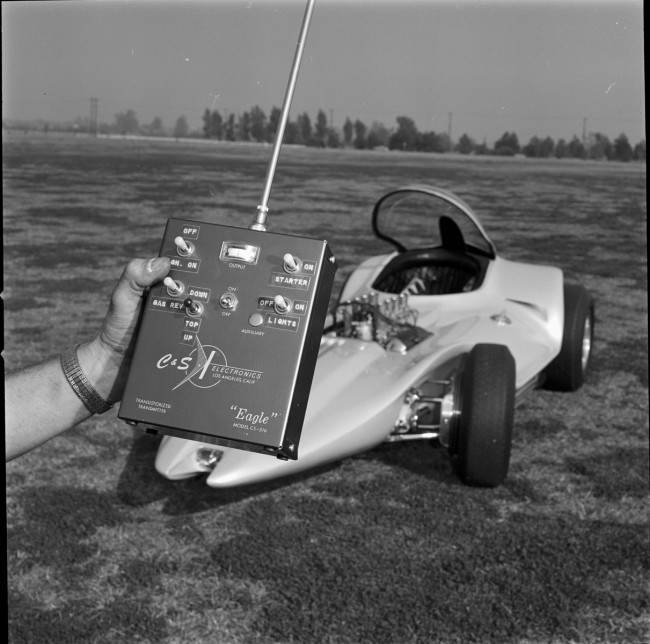
Read more: http://www.streetrodderweb.com/milestones/0011sr_dean_jeffries_manttray/
_________________
We don't care the People Says , Rock 'n' roll is here to stay - Danny & the Juniors - 1958
 Re: The Mantaray - Dean Jeffries
Re: The Mantaray - Dean Jeffries
_________________
We don't care the People Says , Rock 'n' roll is here to stay - Danny & the Juniors - 1958
 Re: The Mantaray - Dean Jeffries
Re: The Mantaray - Dean Jeffries
_________________
We don't care the People Says , Rock 'n' roll is here to stay - Danny & the Juniors - 1958
 Re: The Mantaray - Dean Jeffries
Re: The Mantaray - Dean Jeffries
_________________
We don't care the People Says , Rock 'n' roll is here to stay - Danny & the Juniors - 1958
 The Manta ray - Dean Jeffries
The Manta ray - Dean Jeffries

When the name Dean Jeffries pops up in conversation, most car guys will automatically nod in agreement that, yes, this is one man who truly understands cool customs, wild flames, and precise pinstripes. After all, those were Jeffries's stocks-in-trade when he stepped forward as a major player in the custom car field back in the 1950s. His emerging presence also added credence to the phrase "Von Dutch and The Kid." Back in those days Jeffries hung out with the social-misfit Kenneth Howard, in the process learning his skills as a painter and striper. You've probably figured out by now that Jeffries was "The Kid" of the duo.
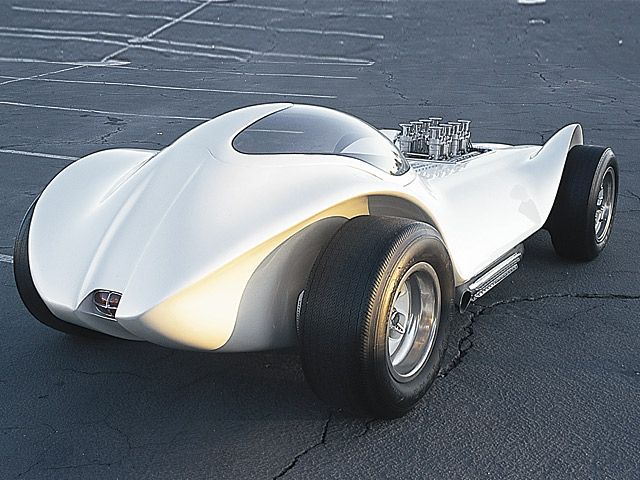
Despite his reputation as a customizer, The Kid's first love happened to be racing. In fact, racing has always been Jeffries's passion, and today he'll tell you, "Racing has been my whole life." His romance with the racetrack eventually led to the creation of the Mantaray, but before you can appreciate why he built this street-rod-cum-show-car, it's best to understand how Jeffries became hooked on racing in the first place.

Jeffries grew up in the town of Compton, California, home of many early-day hot rodders and racers. One aspiring racer who happened to live only a few houses down the block from young Jeffries was Troy Ruttman. Sharing an interest in cars, they became good friends. Ruttman, in particular, happened to be a fledging driver with a promising career. Tall and dashing, with handsome looks and lightning reflexes, Ruttman personified the typical race car driver of that time. In 1949 he landed his first ride at The Brickyard, finishing 12th in the 500 behind the wheel of the Carter Special. By 1951 he was driving for the legendary J.C. Agajanian, and together they won the greatest race of them all in 1952.

That also happened to be the year Ruttman's friend, Dean Jeffries, showed up at Indy with his box of horsehair brushes and paint bottles, ready to do work. He spent the month striping race cars and drivers' helmets, and he established a reputation among Gasoline Alley tenants when he striped the Agajanian car.

"I just worked at it night and day," recalls Jeffries about those early years at Indy. His annual pilgrimages to Indy not only helped him establish a reputation as a hot-shot striper, he also picked up a few race car-building techniques along the way. By 1960 he had become a rather proficient innovator and metalman, although to this day he says he was never truly a fabricator. Maybe history will judge differently, especially for automotive historians who use Mantaray when gauging Jeffries's talents.

But when Jeffries built the Mantaray in 1963, he didn't care about what history held in store for him or his single-seat creation. Instead, he had his eye on the grand prize that Oakland Roadster Show promoter Al Slonaker had posted in the form of the Tournament of Fame. As the name indicates, this was a special competition, open to only a select number of pro-builders. It would be akin to inviting only guys like Boyd Coddington, Roy Brizio, and Ed Pratt to compete for a special prize today. Bill Cushenbery won the first Tournament of Fame, taking home the gold with his bubbletop Silhouette. For his efforts he earned a trip to Europe, a large cash prize, and a free automobile.
_________________
We don't care the People Says , Rock 'n' roll is here to stay - Danny & the Juniors - 1958
 Re: The Mantaray - Dean Jeffries
Re: The Mantaray - Dean Jeffries
The tournament appealed to Jeffries, and he became an entrant for 1964. The car that he planned to build would showcase the talents that he had acquired during the years as a custom car builder, painter, and Gasoline Alley refugee every May at Indianapolis.
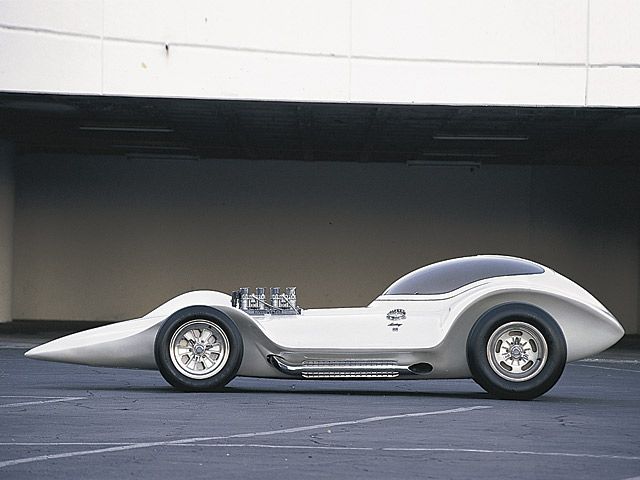
Let's freeze-frame our story for a moment to point out another interesting chapter in Jeffries's career as a car builder. In 1962 he went to work for Carroll Shelby who, at that time, possessed only the idea for the soon-to-be Cobra sports car. Shelby's plan was to take a lightweight two-seat sports car, wedge a brutish American-made V-8 engine under its hood, and go racing. Originally, Shelby ventured to Chevrolet with his proposal, but the Bow Tie boys cordially showed him to the door; as it turned out, they were building a hot-shot version of the new Corvette Sting Ray, called the Z06 racer.

So Shelby did what any enterprising young American would do--he went to the next door on the block, which happened to be Ford Motor Company, and gave the same sales pitch. At the time Ford didn't have anything like the Sting Ray in the works, so they obliged with a couple of small-block V-8 motors for Shelby to play with. When he returned to his headquarters in Los Angeles, Shelby turned Jeffries loose to build the first Cobra, a car based on the aluminum-skinned AC Bristol, a British sports car that pretty much fit the parameters set by Shelby. Moreover, this project allowed Jeffries to hone his aluminum-fabricating skills that would prove invaluable a few months later when he started work on Mantaray.

Jeffries is the first to admit that he's no engineer. Given that, he wasted little time trying to concoct his own chassis for Mantaray. Instead, he dusted off a couple of old Maserati Formula 1 Grand Prix cars that he had acquired a few years earlier from his first father-in-law. Jeffries makes it clear that, contrary to what has been written in the past about his car, Mantaray's frame is not based on the fabled Maserati Birdcage, which happened to be a two-seat sports car. Mantaray is a single seater, based on a Formula 1 car of questionable 1950s vintage: "I really can't remember what year the Maseratis were built," Jeffries points out today.

In any case, he pirated the best parts from both chassis, then went to work building his entry for the 1964 Tournament of Fame. First thing he did was trash the temperamental Italian engines ("Boy, was that a big mistake! Do you realize how much those are worth today?" Jeffries will tell you now.). Naturally, the old sheetmetal was scrapped, too, as were a few other choice parts. But for the most part the frame, suspension, brakes, and steering remain Italian-made. The rest of the car, with exception of the four downdraft Weber carburetors, is true-blue American, right down to the 15-inch magnesium-cast Halibrand wheels and the bred-for-Indianapolis Goodyear Blue Streak Speedway Special tires.
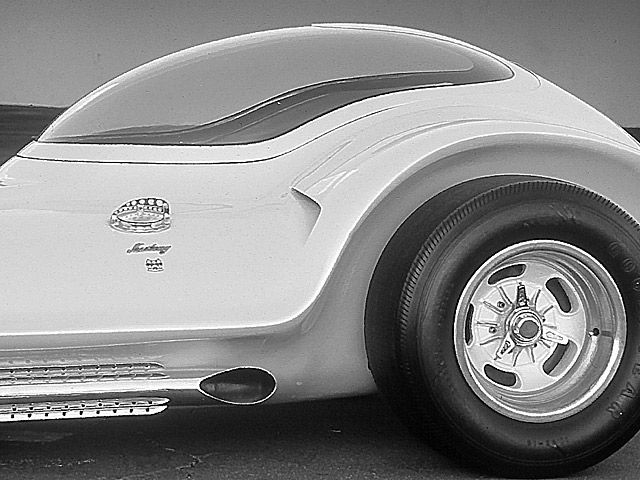
No doubt, Mantaray's curvaceous lines are stunning, reflecting a true work of art. But the real beauty that any skinned-to-the-knuckles street rodder can appreciate is in how Jeffries created that body. First, know this: it took 86 individual pieces of sheet aluminum to form that luscious body, each part pounded into shape by hand. Knowing that, it's challenging to examine the 36-year-old body up close to see where the weld seams lie. Whether you have the eyes of a 62-year-old or a 26-year-old, you'll be hard pressed to see where Jeffries set the bead back in '63.

For all it's worth, the body appears to be formed from a single piece of material. Gaze at it some more and you tangle with another thought: How the heck does it come off the frame? Well, according to Jeffries, the sleek body was engineered for easy removal, and in fact body and frame spent a number of years separated when Mantaray was retired from the show circuit a few years after its conception. Recalls Jeffries, "I really didn't have any use for it (Mantaray) any more, but I didn't want to get rid of it, so I yanked the body and hung it from the ceiling, and parked the rest of the car in the corner of the shop." Fortunately for hot rod posterity he never pilfered parts from the car for other projects, so it took little work to restore Mantaray a few years ago. Essentially, Jeffries applied a new coat of pearl white, polished some odds and ends, and rolled the finished product into the Petersen Automotive Museum where the car resides today.

Let's freeze-frame our story for a moment to point out another interesting chapter in Jeffries's career as a car builder. In 1962 he went to work for Carroll Shelby who, at that time, possessed only the idea for the soon-to-be Cobra sports car. Shelby's plan was to take a lightweight two-seat sports car, wedge a brutish American-made V-8 engine under its hood, and go racing. Originally, Shelby ventured to Chevrolet with his proposal, but the Bow Tie boys cordially showed him to the door; as it turned out, they were building a hot-shot version of the new Corvette Sting Ray, called the Z06 racer.

So Shelby did what any enterprising young American would do--he went to the next door on the block, which happened to be Ford Motor Company, and gave the same sales pitch. At the time Ford didn't have anything like the Sting Ray in the works, so they obliged with a couple of small-block V-8 motors for Shelby to play with. When he returned to his headquarters in Los Angeles, Shelby turned Jeffries loose to build the first Cobra, a car based on the aluminum-skinned AC Bristol, a British sports car that pretty much fit the parameters set by Shelby. Moreover, this project allowed Jeffries to hone his aluminum-fabricating skills that would prove invaluable a few months later when he started work on Mantaray.

Jeffries is the first to admit that he's no engineer. Given that, he wasted little time trying to concoct his own chassis for Mantaray. Instead, he dusted off a couple of old Maserati Formula 1 Grand Prix cars that he had acquired a few years earlier from his first father-in-law. Jeffries makes it clear that, contrary to what has been written in the past about his car, Mantaray's frame is not based on the fabled Maserati Birdcage, which happened to be a two-seat sports car. Mantaray is a single seater, based on a Formula 1 car of questionable 1950s vintage: "I really can't remember what year the Maseratis were built," Jeffries points out today.

In any case, he pirated the best parts from both chassis, then went to work building his entry for the 1964 Tournament of Fame. First thing he did was trash the temperamental Italian engines ("Boy, was that a big mistake! Do you realize how much those are worth today?" Jeffries will tell you now.). Naturally, the old sheetmetal was scrapped, too, as were a few other choice parts. But for the most part the frame, suspension, brakes, and steering remain Italian-made. The rest of the car, with exception of the four downdraft Weber carburetors, is true-blue American, right down to the 15-inch magnesium-cast Halibrand wheels and the bred-for-Indianapolis Goodyear Blue Streak Speedway Special tires.

No doubt, Mantaray's curvaceous lines are stunning, reflecting a true work of art. But the real beauty that any skinned-to-the-knuckles street rodder can appreciate is in how Jeffries created that body. First, know this: it took 86 individual pieces of sheet aluminum to form that luscious body, each part pounded into shape by hand. Knowing that, it's challenging to examine the 36-year-old body up close to see where the weld seams lie. Whether you have the eyes of a 62-year-old or a 26-year-old, you'll be hard pressed to see where Jeffries set the bead back in '63.

For all it's worth, the body appears to be formed from a single piece of material. Gaze at it some more and you tangle with another thought: How the heck does it come off the frame? Well, according to Jeffries, the sleek body was engineered for easy removal, and in fact body and frame spent a number of years separated when Mantaray was retired from the show circuit a few years after its conception. Recalls Jeffries, "I really didn't have any use for it (Mantaray) any more, but I didn't want to get rid of it, so I yanked the body and hung it from the ceiling, and parked the rest of the car in the corner of the shop." Fortunately for hot rod posterity he never pilfered parts from the car for other projects, so it took little work to restore Mantaray a few years ago. Essentially, Jeffries applied a new coat of pearl white, polished some odds and ends, and rolled the finished product into the Petersen Automotive Museum where the car resides today.
_________________
We don't care the People Says , Rock 'n' roll is here to stay - Danny & the Juniors - 1958
 Re: The Mantaray - Dean Jeffries
Re: The Mantaray - Dean Jeffries
It's worth pointing out, too, that the body rests on a series of sub-frame attachment points strategically placed throughout the Maserati frame. "I took tricks for building an Indy car, and used them for this car," explains Jeffries.
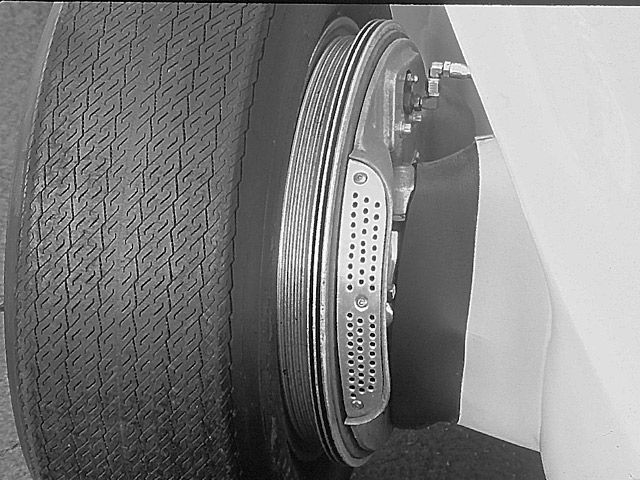
One trick he had to learn himself was in working with plexiglass to form the bubbletop. Bubbletops were vogue among show cars back in the early 1960s, and while some builders enlisted the assistance of huge pizza ovens to mold their Plexiglas tops during that same time, Jeffries fashioned Mantaray's top the old-fashioned way. He used a tube to blow air into molten plastic, until it bubbled to the proper size. "Then I let it cool overnight, came back and cut and formed it," he tells us today. He makes it sound simple, but even Jeffries realizes that what he accomplished was pretty special when he adds, "And I only had to make one!"
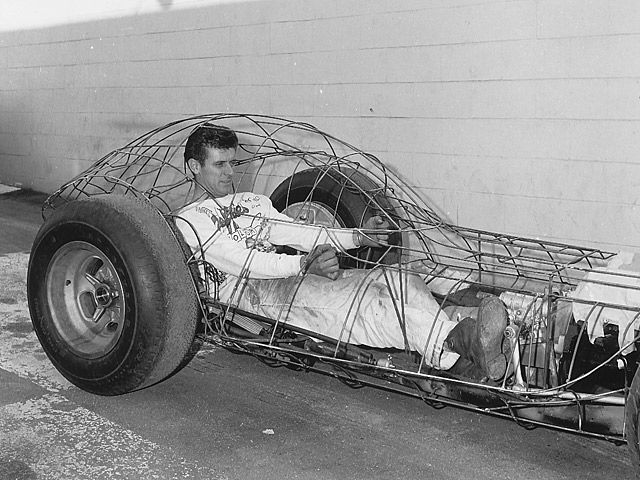
When you listen to Jeffries talk matter-of-factly about how he built this car, you get the impression that he can do anything with his hands. For instance, consider the dragster steering wheel that he formed from ordinary steel stock. Jeffries gives a rather colorful and straightforward description of how he built it: "I just heated it, bent it, then had it chromed." So simple for a guy of his talents.
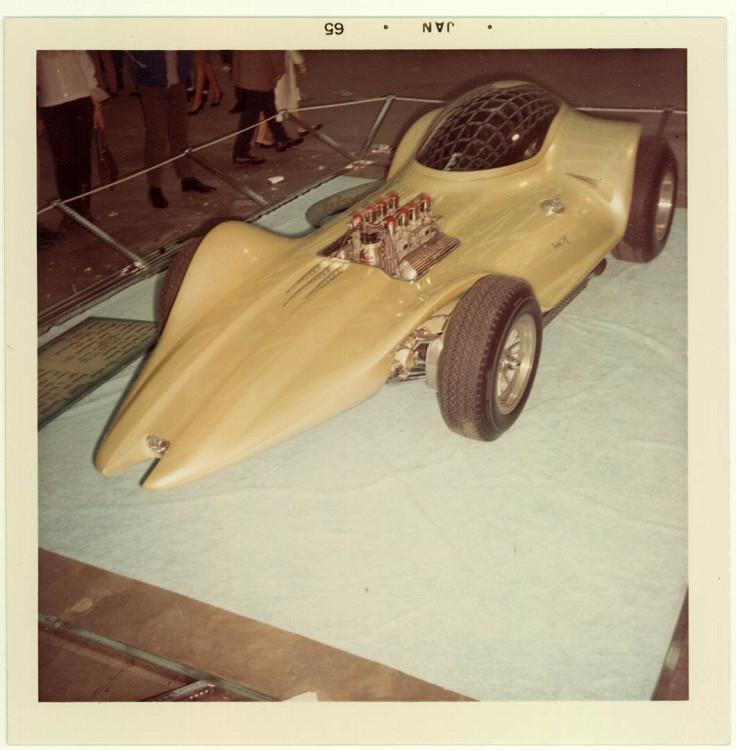
One thing that Jeffries couldn't do himself, though, was stitch the leather upholstery. For that he called on his good friend, Roy Gilbert, whose needle and thread later would help form the interior to many Jeffries creations, including various Hollywood cars such as the Monkeemobile and the Green Hornet's car.
But Mantaray's interior proved to be more difficult to cover with leather than it looks. The seat has multiple curves that converge into a single point, making it difficult to form a contiguous pattern. Even so, Jeffries and Gilbert succeeded in creating a cockpit that followed the car's theme, in which the entire seat cover appears to have been formed from a single piece of cowhide. Jeffries didn't have to apply as much elbow grease with the engine. It's not by chance that he selected a small-block Ford V-8 with Cobra valve covers. Remember, he was working for Shelby at the time, and as partial payment for his work on the Cobra project, Jeffries was rewarded with a complete race-ready motor and 4-speed transmission. Boasts Jeffries today, "And the motor has only a few miles on it." Think about that, all you Cobra fanatics!
Actually, the entire car appears as fresh today as when he rolled it into the Oakland show arena on February 14, 1964. Nine days later, February 23, he rolled out with the Tournament of Fame first-place prize. "I won $10,000, a trip to Europe, and a new car," recalls Jeffries, "so I guess it was worth [building] it."
Later the car appeared in the movie Beach Blanket Bingo, in which a Hollywood character dressed in a gorilla suit made his grand appearance behind the steering wheel. All monkey business aside, Mantaray was a major draw on the show car circuit during the late 1960s, and received a multi-graphic paint job at one point in its life. An air scoop was added, too, in order to give the car a fresh appearance in its waning years as a celebrity feature car.
One more thing worth noting about Mantaray. Jeffries conceived the name one day while he was holed up in his hotel room during the weekend of the Monterey Kar Kapades car show. "I was looking out the window at the ocean," recalls Jeffries, "and I saw a Manta Ray. That's when I decided on the name."
In the process he exercised a little owner's prerogative when he formed the name into a single word. Show promoters and magazine writers insisted on spelling it the proper way--Manta Ray--but Jeffries says the name should be spelled as one word. Which makes sense, because it helps maintain the purity and integrity of the design. A design that pleases the eye with its flowing, one-piece beauty, making this perhaps the first smoothie street rod ever built. Think about that while you search for the 86 individual body sections of Mantaray.
Read more: http://www.hotrod.com/features/history/articles/0011sr-dean-jeffries-manttray/

One trick he had to learn himself was in working with plexiglass to form the bubbletop. Bubbletops were vogue among show cars back in the early 1960s, and while some builders enlisted the assistance of huge pizza ovens to mold their Plexiglas tops during that same time, Jeffries fashioned Mantaray's top the old-fashioned way. He used a tube to blow air into molten plastic, until it bubbled to the proper size. "Then I let it cool overnight, came back and cut and formed it," he tells us today. He makes it sound simple, but even Jeffries realizes that what he accomplished was pretty special when he adds, "And I only had to make one!"

When you listen to Jeffries talk matter-of-factly about how he built this car, you get the impression that he can do anything with his hands. For instance, consider the dragster steering wheel that he formed from ordinary steel stock. Jeffries gives a rather colorful and straightforward description of how he built it: "I just heated it, bent it, then had it chromed." So simple for a guy of his talents.

One thing that Jeffries couldn't do himself, though, was stitch the leather upholstery. For that he called on his good friend, Roy Gilbert, whose needle and thread later would help form the interior to many Jeffries creations, including various Hollywood cars such as the Monkeemobile and the Green Hornet's car.
But Mantaray's interior proved to be more difficult to cover with leather than it looks. The seat has multiple curves that converge into a single point, making it difficult to form a contiguous pattern. Even so, Jeffries and Gilbert succeeded in creating a cockpit that followed the car's theme, in which the entire seat cover appears to have been formed from a single piece of cowhide. Jeffries didn't have to apply as much elbow grease with the engine. It's not by chance that he selected a small-block Ford V-8 with Cobra valve covers. Remember, he was working for Shelby at the time, and as partial payment for his work on the Cobra project, Jeffries was rewarded with a complete race-ready motor and 4-speed transmission. Boasts Jeffries today, "And the motor has only a few miles on it." Think about that, all you Cobra fanatics!
Actually, the entire car appears as fresh today as when he rolled it into the Oakland show arena on February 14, 1964. Nine days later, February 23, he rolled out with the Tournament of Fame first-place prize. "I won $10,000, a trip to Europe, and a new car," recalls Jeffries, "so I guess it was worth [building] it."
Later the car appeared in the movie Beach Blanket Bingo, in which a Hollywood character dressed in a gorilla suit made his grand appearance behind the steering wheel. All monkey business aside, Mantaray was a major draw on the show car circuit during the late 1960s, and received a multi-graphic paint job at one point in its life. An air scoop was added, too, in order to give the car a fresh appearance in its waning years as a celebrity feature car.
One more thing worth noting about Mantaray. Jeffries conceived the name one day while he was holed up in his hotel room during the weekend of the Monterey Kar Kapades car show. "I was looking out the window at the ocean," recalls Jeffries, "and I saw a Manta Ray. That's when I decided on the name."
In the process he exercised a little owner's prerogative when he formed the name into a single word. Show promoters and magazine writers insisted on spelling it the proper way--Manta Ray--but Jeffries says the name should be spelled as one word. Which makes sense, because it helps maintain the purity and integrity of the design. A design that pleases the eye with its flowing, one-piece beauty, making this perhaps the first smoothie street rod ever built. Think about that while you search for the 86 individual body sections of Mantaray.
Read more: http://www.hotrod.com/features/history/articles/0011sr-dean-jeffries-manttray/
_________________
We don't care the People Says , Rock 'n' roll is here to stay - Danny & the Juniors - 1958
 Re: The Mantaray - Dean Jeffries
Re: The Mantaray - Dean Jeffries
The holy grail of the hot rod generation was to be able to fabricate beautiful car bodies in steel and other materials. Many of the kids who became Hot Rod building legends had honed their fabrication skills in the hot house of the WW2 American economy. The war ended and charged-up servicemen came home and wanted the buzz of driving fast cars. It was boom time in America and everything seemed possible.
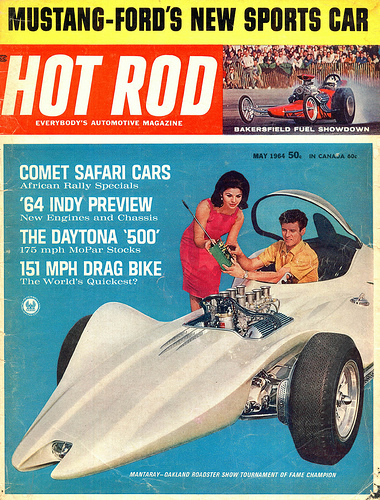
Dean Jeffries was one of this generation of brilliant mechanics and fabricators with an audacious enough vision to dream with his eyes wide open. Having worked extensively with AC Cobra creator Carroll Shelby, he began to build the Mantaray in 1963 in response to a call for submissions to a high prestige competition that had been posted by a promoter called Al Slonaker.
The single piece, canopied body of Mantaray set a new Roddin' precedent
The young Californian fused two old Maserati single seater chassis he had acquired and welded them together. The suspension, brakes, and steering were kept on for the finished article but apart from four Weber carburetors, the car was, he told Street Rodder Magazine recently "true-blue American, right down to the 15-inch magnesium-cast Halibrand wheels and the bred-for-Indianapolis Goodyear Blue Streak Speedway Special tires."
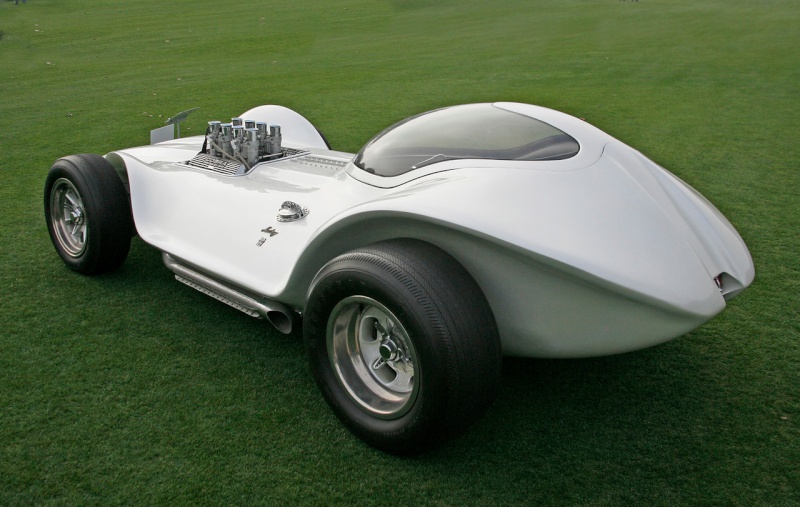
Unsurprisingly, the gorgeously curvacious body Jeffries created (which was, apparently, hand-built from no less than 86 sheets of metal), was enough to win him the 'contest of fame'. This not only won him a prize of $10,000 and a trip to Europe, but also changed the way the world thought about Hot Rods.
This is what we call truly creative car culture. And we love it
- See more at: http://www.influx.co.uk/wordpress/blog/mantaray-by-dean-jeffries/

Dean Jeffries was one of this generation of brilliant mechanics and fabricators with an audacious enough vision to dream with his eyes wide open. Having worked extensively with AC Cobra creator Carroll Shelby, he began to build the Mantaray in 1963 in response to a call for submissions to a high prestige competition that had been posted by a promoter called Al Slonaker.
The single piece, canopied body of Mantaray set a new Roddin' precedent
The young Californian fused two old Maserati single seater chassis he had acquired and welded them together. The suspension, brakes, and steering were kept on for the finished article but apart from four Weber carburetors, the car was, he told Street Rodder Magazine recently "true-blue American, right down to the 15-inch magnesium-cast Halibrand wheels and the bred-for-Indianapolis Goodyear Blue Streak Speedway Special tires."

Unsurprisingly, the gorgeously curvacious body Jeffries created (which was, apparently, hand-built from no less than 86 sheets of metal), was enough to win him the 'contest of fame'. This not only won him a prize of $10,000 and a trip to Europe, but also changed the way the world thought about Hot Rods.
This is what we call truly creative car culture. And we love it
- See more at: http://www.influx.co.uk/wordpress/blog/mantaray-by-dean-jeffries/
_________________
We don't care the People Says , Rock 'n' roll is here to stay - Danny & the Juniors - 1958
 Re: The Mantaray - Dean Jeffries
Re: The Mantaray - Dean Jeffries
It’s the early 1960’s and Dean Jeffries wants to make a name for himself. He sees guys like Bill Cushenberry and George Barris winning big trophies and taking home big checks and realizes the bar has been set – all he has to do is leap over it. By 1963, Dean has perfected his craft and is confident enough to set a goal. Hell or high water, he was going to win the Oakland Show. Doing so would not only give him a name, but set him up with a large cash prize, a free trip to Europe, and a brand new car.

Of course, none of that would come easy. Winning the Oakland Roadster Show was a kin to winning the Super Bowl. It took talent, a ton of hard work, and maybe even a little luck. None of that deterred Dean, however, and it wasn’t long before the Mantaray was under construction.

As luck would have it, Dean’s father-in-law had a couple of pre-war Maserati Formula cars sitting in his back yard. Dean asked nicely, the man obliged, and when it was all said and done, the Mantaray had an extremely sophisticated foundation to begin life with. From there, Dean took a ton of quarter-inch rod and just started bending a shape he had in his head. Once finished, he dropped the whole lot off at California Metal Shaping and for $800, they formed the body.

Mechanicals were next. Dean did some work with Carol Shelby on the Cobra and as trade, took a nicely prepared and webber inducted 289. It fit the car perfectly and gave the Indy inspired ride all of the required grunt. As mentioned earlier though, the frame and most of the remaining mechanicals are all Maserati – including the gorgeous drum brakes, beautifully proportioned rear-diff, and highly sophisticated (at the time) independent front suspension.

The final touch was a typical one in the early 1960’s – a bubble top. Dean blew it himself and amazingly, only had to do the deed once. I’ve heard it said that Dean never really understood the bubble fad, thought they ruined drive ability, but did it anyway as he felt he needed the feature to compete. Whatever the case, you can’t argue the final look. Neither could the judges – Dean took the Roadster Show and all of the goodies that came with it.

The car now sits fully restored in the Petersen Automotive Museum.

http://www.jalopyjournal.com/?p=3698

Of course, none of that would come easy. Winning the Oakland Roadster Show was a kin to winning the Super Bowl. It took talent, a ton of hard work, and maybe even a little luck. None of that deterred Dean, however, and it wasn’t long before the Mantaray was under construction.

As luck would have it, Dean’s father-in-law had a couple of pre-war Maserati Formula cars sitting in his back yard. Dean asked nicely, the man obliged, and when it was all said and done, the Mantaray had an extremely sophisticated foundation to begin life with. From there, Dean took a ton of quarter-inch rod and just started bending a shape he had in his head. Once finished, he dropped the whole lot off at California Metal Shaping and for $800, they formed the body.

Mechanicals were next. Dean did some work with Carol Shelby on the Cobra and as trade, took a nicely prepared and webber inducted 289. It fit the car perfectly and gave the Indy inspired ride all of the required grunt. As mentioned earlier though, the frame and most of the remaining mechanicals are all Maserati – including the gorgeous drum brakes, beautifully proportioned rear-diff, and highly sophisticated (at the time) independent front suspension.

The final touch was a typical one in the early 1960’s – a bubble top. Dean blew it himself and amazingly, only had to do the deed once. I’ve heard it said that Dean never really understood the bubble fad, thought they ruined drive ability, but did it anyway as he felt he needed the feature to compete. Whatever the case, you can’t argue the final look. Neither could the judges – Dean took the Roadster Show and all of the goodies that came with it.

The car now sits fully restored in the Petersen Automotive Museum.

http://www.jalopyjournal.com/?p=3698
_________________
We don't care the People Says , Rock 'n' roll is here to stay - Danny & the Juniors - 1958
 Re: The Mantaray - Dean Jeffries
Re: The Mantaray - Dean Jeffries
_________________
We don't care the People Says , Rock 'n' roll is here to stay - Danny & the Juniors - 1958
 Re: The Mantaray - Dean Jeffries
Re: The Mantaray - Dean Jeffries

Dean Jeffries Mantaray 22” 1:8 Car
PRODUCT DESCRIPTION:
Place Pre-Orders by Friday Nov. 20 to guarantee delivery!
Dean Jeffries Mantaray 22" 1:8 Car :
If you knew the Hot Rod scene back in the 60's, you know this iconic car.
Pre-orders are now being accepted, only 200
models are being built. This will not be a stock item, so pre-ordering is the
only way to receive one. It's big, it's heavy, and it's expensive. But if you have customers that like the big scale models, then this is one to consider.
http://www.monstersinmotion.com/cart/spaceships-vehicles-item-list-a-e-c-13_191/dean-jeffries-mantaray-22-1-8-car-p-17940
For more information click here.
Model Features:
- Huge 1:8 scale by Structo
- 22 inches long
- Weighs 12 pounds
- Limited Edition of just 200
- Available January 2013
_________________
We don't care the People Says , Rock 'n' roll is here to stay - Danny & the Juniors - 1958
 Re: The Mantaray - Dean Jeffries
Re: The Mantaray - Dean Jeffries
_________________
We don't care the People Says , Rock 'n' roll is here to stay - Danny & the Juniors - 1958
 Re: The Mantaray - Dean Jeffries
Re: The Mantaray - Dean Jeffries
_________________
We don't care the People Says , Rock 'n' roll is here to stay - Danny & the Juniors - 1958
 Re: The Mantaray - Dean Jeffries
Re: The Mantaray - Dean Jeffries
_________________
We don't care the People Says , Rock 'n' roll is here to stay - Danny & the Juniors - 1958
 Re: The Mantaray - Dean Jeffries
Re: The Mantaray - Dean Jeffries
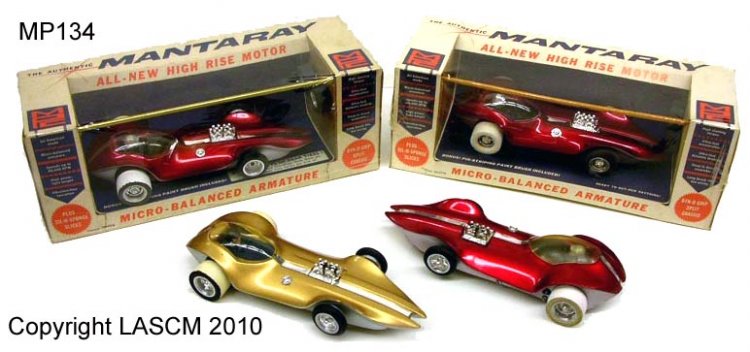
Manta Ray RTR
This extraordinary machine was modeled after a Dean Jeffries custom car built from an old Maserati Grand Prix chassis fitted with a modified Ford 289 c.i. engine. Issued in 1967, the model used a Fred Rannalli chassis made of two pieces of hinged aluminum, a motor bracket for the MPC "High Rise" motor and a new MPC guide flag. The front wheels were the usual MPC narrow jobs with finned drum "brakes" fitted with the ribbed "O-Ring" tires, but the rear wheels were now fitted with white sponge tires coated with white silicone. Some had their sidewalls painted black for more "realism", a curious term when the tread was obviously white. The wheels first received the usual MPC sunburst hubcaps with separate 3-prong knock-offs, but later 1968 issues had a one-piece "Halibrand" kidney-bean insert. The bodies were blow-molded styrene painted in gold or metallic red, with a silver lower part. The blow molding technique allowed the use of separate injected and plated accessories such as engine detail and driver head. An injected clear-plastic canopy is also fitted. The model was quite successful but while many have survived, few have retained their original box that also contained a spare set of rear sponge tires mounted on aluminum wheels. only one is known to have survived in sealed condition, the clear cellophane box covering hanging over a paint brush that formed the top edge of the box.

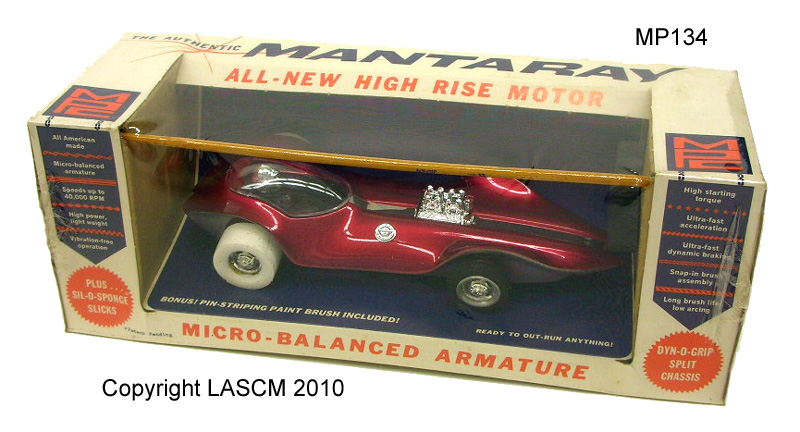
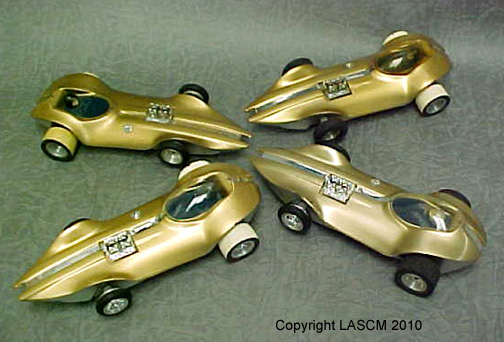
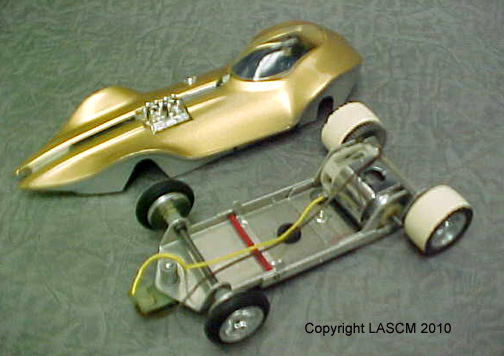

http://lascm.com/Slot-Car-Museum/index.php?main_page=product_info&cPath=4_1183_1185&products_id=6510
_________________
We don't care the People Says , Rock 'n' roll is here to stay - Danny & the Juniors - 1958
 Re: The Mantaray - Dean Jeffries
Re: The Mantaray - Dean Jeffries
_________________
We don't care the People Says , Rock 'n' roll is here to stay - Danny & the Juniors - 1958
 Re: The Mantaray - Dean Jeffries
Re: The Mantaray - Dean Jeffries
_________________
We don't care the People Says , Rock 'n' roll is here to stay - Danny & the Juniors - 1958
 Re: The Mantaray - Dean Jeffries
Re: The Mantaray - Dean Jeffries
_________________
We don't care the People Says , Rock 'n' roll is here to stay - Danny & the Juniors - 1958
 Re: The Mantaray - Dean Jeffries
Re: The Mantaray - Dean Jeffries
_________________
We don't care the People Says , Rock 'n' roll is here to stay - Danny & the Juniors - 1958
 Sujets similaires
Sujets similaires» Grand National Roadster Show 1962 - 66 (GNRS)
» Dean JEFFRIES
» RIP Dean Jeffries
» Slot racing
» 1956 Porsche 356 A Carrera GS - Dean Jeffries
» Dean JEFFRIES
» RIP Dean Jeffries
» Slot racing
» 1956 Porsche 356 A Carrera GS - Dean Jeffries
Traditional Kustom Hot Rod and Vintage Culture and design :: Mild & radical Custom cars database :: Concept Custom Car
Page 1 sur 1
Permission de ce forum:
Vous ne pouvez pas répondre aux sujets dans ce forum
 Connexion
Connexion
